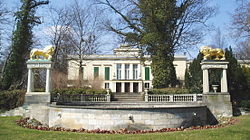This article needs additional citations for verification. (January 2021) |
You can help expand this article with text translated from the corresponding article in German. (September 2014) Click [show] for important translation instructions.
|
Glienicke Palace (German: Schloss Glienicke) is a historic palace located on the peninsula of Berlin-Wannsee in Germany. It was designed by Karl Friedrich Schinkel around 1825 for Prince Carl of Prussia.[1] Since 1990, Glienicke Palace and the park have been part of the UNESCO World Heritage Site "Palaces and Parks of Potsdam and Berlin" because of their unique contribution to Prussian landscape architecture.[2]
| Glienicke Palace | |
|---|---|
Schloss Glienicke | |
 | |
| General information | |
| Type | Palace |
| Architectural style | Neoclassical |
| Town or city | Berlin |
| Country | Germany |
| Coordinates | 52°24′50″N 13°05′42″E / 52.414°N 13.095°E |
| Client | Prince Carl of Prussia |
| Owner | Stiftung Preußische Schlösser und Gärten Berlin-Brandenburg |
| Design and construction | |
| Architect(s) | Karl Friedrich Schinkel |
| Website | |
| Official website | |
| Part of | Palaces and Parks of Potsdam and Berlin |
| Criteria | Cultural: (i)(ii)(iv) |
| Reference | 532ter |
| Inscription | 1990 (14th Session) |
| Extensions | 1992, 1999 |
Location
editThe palace is situated near the Glienicke Bridge, on the Bundesstraße 1 across from the Glienicke Hunting Lodge. Around the palace is Park Glienicke.
History
editThe palace was designed by Karl Friedrich Schinkel for Prince Carl of Prussia. The building, originally merely a cottage, was turned into a summer palace in the late Neoclassical style. Inside the palace were antique objets d'art which Prince Carl of Prussia brought back from his trips.
Particularly striking are two golden lion statues in front of the south frontage, which were also designed by Schinkel. The lions are versions of the "Medici lions" from the Villa Medici in Rome.
The palace is administered by the Stiftung Preußische Schlösser und Gärten Berlin-Brandenburg. The palace's park is now called the Volkspark Glienicke.
Gallery
edit-
Garden-courtyard in Glienicke (1837) by August C. Haun
-
The courtyard of Glienicke Palace
See also
editReferences
edit- ^ "Glienicke Palace". Archived from the original on 2019-07-11. Retrieved 2019-10-01.
- ^ "Palaces and Parks of Potsdam and Berlin". UNESCO World Heritage Centre. United Nations Educational, Scientific, and Cultural Organization. Archived from the original on 8 August 2008. Retrieved 12 Jun 2022.
External links
edit- Glienicke Palace Archived 2019-07-11 at the Wayback Machine
- Potsdam from Above – Schloss Glienicke Archived 2007-09-27 at the Wayback Machine


